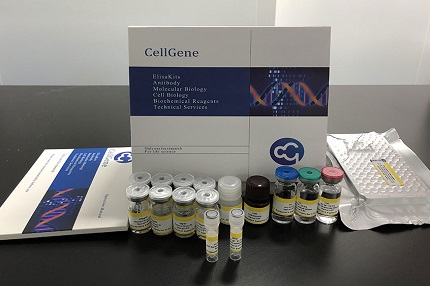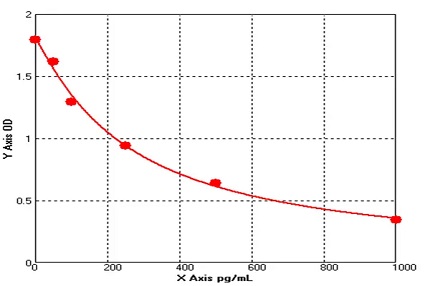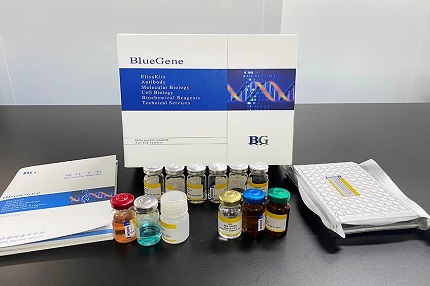E02D0033 Rat Deoxypyridinoline ELISA kit
The Rat Deoxypyridinoline ELISA kit can be used to identify samples from the rat species. Deoxypyridinoline can also be called DPD, DPYD;DHPDHase, Dihydrothymine, dehydrogenase, Dihydrouracil dehydrogenase.


E02D0033 Rat Deoxypyridinoline ELISA kit
The Rat Deoxypyridinoline ELISA kit can be used to identify samples from the rat species. Deoxypyridinoline can also be called DPD, DPYD;DHPDHase, Dihydrothymine, dehydrogenase, Dihydrouracil dehydrogenase.
Product Information | |
Cat. No. | E02D0033 |
Product Name | Rat Deoxypyridinoline ELISA kit |
Species | Rat |
Product Size | 48 Tests / 96 Tests |
Concentration | 5-100 nmol/L |
Sensitivity | 1.0 nmol/L |
Principal | Sandwich ELISA |
Sample Volume | 50 ul |
Sample Type | Serum, plasma, cell culture supernatants, body fluid and tissue homogenate |
Assay Time | 90 minutes |
Platform | Microplate Reader |
Conjugate | HRP |
Detection Method | Colorimetric |
Storage | 2-8°C |
Kit Components | ||
MATERIALS | SPECIFICATION | QUANTITY |
MICROTITER PLATE | 96 wells | stripwell |
ENZYME CONJUGATE | 10 mL | 1 vial |
STANDARD A (0.5mL) | 0 nmol/L | 1 vial |
STANDARD B (0.5mL) | 5.0 nmol/L | 1 vial |
STANDARD C (0.5mL) | 10 nmol/L | 1 vial |
STANDARD D (0.5mL) | 25 nmol/L | 1 vial |
STANDARD E (0.5mL) | 50 nmol/L | 1 vial |
STANDARD F (0.5mL) | 100 nmol/L | 1 vial |
SUBSTRATE A | 6 mL | 1 vial |
SUBSTRATE B | 6 mL | 1 vial |
STOP SOLUTION | 6 mL | 1 vial |
WASH SOLUTION (100 x) | 10 mL | 1 vial |
BALANCE SOLUTION | 3 mL | 1 vial |
Principle of the Assay |
DPD ELISA kit applies the quantitative sandwich enzyme immunoassay technique. The microtiter plate has been pre-coated with a monoclonal antibody specific for DPD. Standards or samples are then added to the microtiter plate wells and DPD if present, will bind to the antibody pre-coated wells. In order to quantitatively determine the amount of DPD present in the sample, a standardized preparation of horseradish peroxidase (HRP)-conjugated polyclonal antibody, specific for DPD are added to each well to “sandwich” the DPD immobilized on the plate. The microtiter plate undergoes incubation, and then the wells are thoroughly washed to remove all unbound components. Next, substrate solutions are added to each well. The enzyme (HRP) and substrate are allowed to react over a short incubation period. Only those wells that contain DPD and enzyme-conjugated antibody will exhibit a change in color. The enzyme-substrate reaction is terminated by addition of a sulphuric acid solution and the color change is measured spectrophotometrically at a wavelength of 450 nm. A standard curve is plotted relating the intensity of the color (O.D.) to the concentration of standards. The DPD concentration in each sample is interpolated from this standard curve. |
Coefficient of Variance | Intra Variation% <10% | |
Inter Variation% <12% | ||
Recovery | 95-102% | |
Linearity | Diluent Ratio | Range % |
1:2 | 93-105 | |
1:4 | 88-106 | |
1:8 | 86-108 | |
Specificity/Cross-reactivity | No significant cross-reactivity or interference between DPD and analogues was observed. | |




E02D0033 has been referenced in the below publications:
Involvement of periostin-sclerostin-Wnt/β-catenin signaling pathway in the prevention of neurectomy-induced bone loss by naringin.
Related Bluegene Biotech Products



